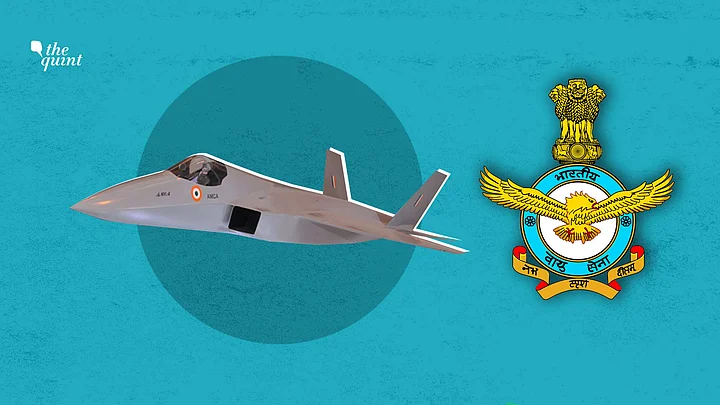(This is the first article in The Quint’s two-part series on India’s fifth generation fighter aircraft, to be developed by DRDO and produced by HAL and an Indian private company. You can read the second part here.)
A public-private partnership between DRDO’s Aeronautical Development Agency (ADA), Hindustan Aeronautics Limited (HAL) and a private Indian company is expected to be formalised soon upon receipt of government sanction for the Advanced Medium Combat Aircraft (AMCA).
AMCA will pitchfork India into an exclusive group of a handful of countries that design, develop and operate fifth generation fighter aircraft (FGFA).
Presently, Lockheed Martin’s F-22 Raptor, F-35 Lightning II and Chinese Chengdu J-20 are the only combat-ready FGFA.
What started as a possible Russian platform over time turned into India’s Medium Combat Aircraft and now AMCA. An Indo-Russian collaboration inked in 2007 to develop the Su-57 FGFA fell through in 2018 after India formally withdrew stating prohibitive developmental costs proposed by the Russians.
The program will spawn a host of tier 2/3 suppliers and sub-vendors downstream. It is understood that sanction from Cabinet Committee on Security (CCS) is being pursued by DRDO. There was hope before the pandemic that DRDO will be able to get this approval by end-2020, opening the road for a big dollop of funding. The changed economic landscape post COVID-19 may delay this somewhat.
India’s AMCA – At a Glance
Starting 2010, IAF had indicated key design drivers for the AMCA and drawn Aeronautical Development Agency (ADA), DRDO’s aviation research wing, into the loop. Today, a small geographically-dispersed but well-networked project team in ADA is giving shape to the AMCA. Here are some features that make the AMCA a fifth generation fighter:
- Advanced stealth features through design and materials
- 5th gen twin-engine multirole fighter with “some 6th-gen technologies”
- Aircraft with Artificial Intelligence (AI)
- Multi-sensor data fusion (MSDF) and 3D audio for enhanced situational awareness
- Advanced cockpit with large area display (LAD), touchscreen and 3D display for excellent user interface
- Quadruplex digital fly-by-wire control system with HOTAS-configured side stick controller and unified throttle
- Automated takeoff and landing (ATOL), automated missions and auto air-to-air refuelling (Auto AAR)
- Voice-activated commands § Imported F414-GE-INS6 engines with 98 kN dry thrust for first two squadrons; indigenous 110 kN engine for next five.
- Supersonic cruise on dry thrust (only with 110 kN engines)
- Internal carriage of precision weapons (for stealth & supercruise)
- Super-manoeuvrability through thrust-vectoring (unlikely in initial batch with 98 kN engine)
Is AMCA the ‘Best Course of Action’?
Having staked responsibility for the lion’s share of India’s future air power with the AMCA, LCA Mk2, TEDBF, ORCA et al, user services have now — for better or worse — walked into a party hosted by DRDO (but funded by services), with no clear exit plan should the script go awry.
In this climate of propaganda, nationalism and headwinds of ‘atma nirbharta’, flaunting one acronym after another, and testing ad-infinitum, has become fashionable.
While nobody contests the long-term goal of self-reliance, it may be a good point to reflect on whether singular dependence on ‘DRDO/HAL with private Indian partner’ is the best option for filling critical capability gaps. Which single agency will be answerable and accountable for the lofty promises made? What competition or existential threats do these entities face? What is their incentive for timely delivery and proof of product? What is the penalty for failure?
These questions must haunt us as we drool over the AMCA mock-ups that will be paraded at Aero India 2021.
Lessons From the LCA Project
Air Marshal Raghunath Nambiar, test pilot, Kargil War veteran and former AOC-in-C Western Air Command sounds a siren of caution. He, along with Sqn Ldr Uday Shankar, was the first IAF crew deputed ex-ASTE to form NFTC inside the circular ADA building in 1994. He recalls how the initial support from British Aerospace (BAE), Lockheed Martin Control Systems (LMCS), General Electric and—most importantly—the subsequent withdrawal of all American support in the wake of 1998 Pokhran blasts, were crucial to LCA project’s success.
Pathfinding scientists like Srinath Kumar, Shyam Chetty and Girish Deodhare (now Director ADA), and many others were harnessed by the Program Director Dr Kota Harinarayana who had direct access to then DG, ADA.
That degree of autonomy in finance and decision-making was crucial for LCA, as it would be for the AMCA, Air Marshal Nambiar feels.
While celebrating the many successes of LCA, he rued disappointments like LCA’s laundry list of deficiencies from ASR 2/85, shifting timelines of LCA Mk2, poor product support and under-developed supply chain management, lack of a robust ILS, maintenance issues and production quality of LCA, et al.
Nambiar hopes these lessons will get the attention of our decision makers on AMCA and will result in selection of appropriate choices for making up the deep deficit in fighter squadrons (30 against 42 as of 2020).
(Capt KP Sanjeev Kumar is a former navy test pilot and blogs atwww.kaypius.com. He can be reached at @realkaypius. He has flown over 24 types of fixed and rotary wing aircraft and holds a dual ATP rating on the Bell 412 and AW139 helicopters. This is an opinion piece. The views expressed above are the author’s own. The Quint neither endorses nor is responsible for them.)
